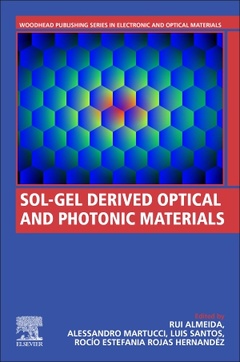Description
Sol-Gel Derived Optical and Photonic Materials
Woodhead Publishing Series in Electronic and Optical Materials Series
Coordinators: Almeida Rui, Martucci Alessandro, Santos Luis, Estefanía Rojas Hernández Rocío
Language: English
Subjects for Sol-Gel Derived Optical and Photonic Materials:
Keywords
Stöber silica; Porosity; Surface chemistry; Hydrolysis–condensation kinetics; Hydrophobic coatings; Dip coating; Spin coating; Meniscus coating; Laser damage; Adsorption isotherm; TiO2; Immobilization; Coatings; Sol–gel; Anodic oxidation; Heterogeneous photocatalysis; Water decontamination; Multilayer films; Photonic crystals; Bragg mirrors; Fabry–Perot microcavities; Lanthanide dopants; Sol–gel material oxide material; Photonic crystal slab; Nanoimprint lithography; Colloidal crystals; Inverse opals; Self-assembly; Photonic band gap; Sensors; Mechanochromic structures; Rare earths; Chemical and biomedical applications; Photovoltaics; Spectral conversion; Luminescent solar concentrators; Layers; Hybrid materials; Planar waveguides; Propagation loss; Photosensitive; Patterning; Nanocomposites; Quantum dots; Core–shell quantum dots; Nonlinear optical applications; Oxyfluoride glass–ceramics; Nanocrystal; Crystallization mechanisms
394 p. · 15x22.8 cm · Paperback
Description
/li>Contents
/li>Readership
/li>Biography
/li>Comment
/li>
Sol-gel processing is a low temperature, low cost wet chemistry route to a range of different materials, particularly glassy and ceramic oxides, including nanoparticles and powders, fibers, thin films and membranes, or monoliths and composites. Thin films and coatings represent by far the most important category of sol-gel derived products with optical, electronic and magnetic functionalities, for example photoresist and dielectric spin-on-glass layers, flat screen displays, anti-reflection, conducting and magnetic disk coatings, as well as photochromic, electrochromic and photovoltaic coatings. Sol-gel derived materials are homogeneous at the molecular level and are a good example of a bottom-up approach to materials synthesis. There is increasing need of new optical and photonic materials with improved performance, where molecular level homogeneity and easy fabrication in film form may be especially convenient, highlighting a decisive advantage of sol-gel over other more established technologies to obtain graded index optical components, solar control coatings, phosphors, glass ceramics or multilayer photonic structures.
There is no book available yet which focuses in particular on optical and photonic sol-gel derived materials. This is what makes this book unique at this point for those especially or exclusively interested in optical and photonic functional materials and applications. This book represents an important tool to update scientists and engineers with recent advances in the rapidly evolving field of optical and photonic materials, components and devices. Our target audience are those working in materials science, physics, engineering and chemistry disciplines, in particular academics and researchers working in advanced optical/photonic processing technologies, research and development engineers in high technology industries and research project leaders. This book will also be an essential tool for graduate students pursuing a PhD or even a Master?s degree.
2. Sol–gel derived anti-reflective coatings for high fluence lasers
3. TiO2 coatings prepared by sol-gel and electrochemical methodologies
4. One-dimensional multilayer photonic crystals
5. Design and implementation of 2-D photonic crystals using sol–gel materials
6. 3D-photonic crystals: Opal structures
7. Photovoltaic spectral conversion materials: The role of sol–gel processing
8. Hybrid materials for patterning and waveguiding
9. Semiconductor quantum dot-doped sol–gel materials
10. Lanthanide-doped oxyfluoride transparent glass–ceramics prepared by sol–gel
11. Sol–gel derived phosphors for optical applications
12. Optical gas sensors
13. Sol–Gel materials for optical and electrooptical applications
14. Sol–gel materials for optical fibers
15. Multifunctional magnetic, optical and electrical nanomaterials processed by sol–gel method
Researchers in Materials Science, Physics, Engineering, and Chemistry disciplines working in academia and R&D disciplines
Dr. A. Martucci received his Ph.D. degree in Materials Engineering from University of Bologna Italy, in 1997. He has started his research and teaching activity at University of Padova, Italy, in the field of glass, ceramics and nanocomposite films obtained by wet chemistry processing for photonic, optical and gas sensor applications. From 2019, he is full professor of Materials Science Engineering at Padova University. He has published over 250 scientific papers in peer-reviewed international journals. He is editorial board member of several materials science international journals He is Fellow of the American Ceramic Society (USA) and the International Sol-Gel Society.
Luis Santos re
- Reviews wide range of sol-gel derived coatings including reflective and anti-reflective, self-cleaning, and electrochromic
- Discusses latest advances in sol-gel derived photonic crystals including one dimensional, two dimensional, and three dimensional structures
- Addresses key applications in solid state lighting, solar cells, sensors, fiber optics, and magneto-optical devices
These books may interest you

Sol-Gel Nanocomposites 105.49 €



